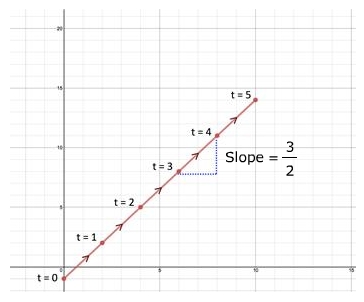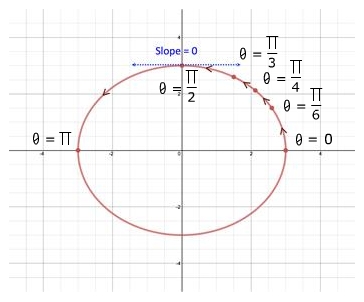Parametric Equations: Derivatives
PARAMETRIC FORM OF THE DERIVATIVE:
If a smooth curve C is given by the continuous functions x = f(t) and y = g(t), then the slope of C and point (x, y) is as follows:
First derivative
Second derivative
Let's try a couple of examples.
|
Step 1: Determine the first derivative of both parametric equations with respect to the parameter, and . |
First parametric equation x = 2t Original First derivative Second parametric equation y = 3t - 1 Original First derivative |
|||||||||||||||||||||
|
Step 2: Substitute and into the parametric derivative equation for the first derivative and calculate the slope, .
|
1 Deriv. Equation Substitute |
|||||||||||||||||||||
|
Step 3: Substitute and into the parametric derivative equation for the second derivative and determine concavity.
|
2 Deriv. Equation Substitute Take derivative |
|||||||||||||||||||||
|
Step 4: Describe the graph at t = 4. The slope and concavity of the plane curve at t = 4 is slope and concavity does not exist. Parametric Equations: x = 2t , y = 3t - 1
|
||||||||||||||||||||||
|
Step 1: Determine the first derivative of both parametric equations with respect to the parameter, and . |
First parametric equation Original First derivative Second parametric equation Original First derivative |
|||||||||||||||||||||
|
Step 2: Substitute and into the parametric derivative equation for the first derivative and calculate the slope, .
|
1 Deriv. Equation Substitute Simplify Rewrite Find slope at |
|||||||||||||||||||||
|
Step 3: Substitute and into the parametric derivative equation for the second derivative and determine concavity.
|
2 Deriv. Equation Substitute Take deriv. Find concavity at Concave down |
|||||||||||||||||||||
|
Step 4: Describe the graph at . The slope and concavity of the plane curve at is slope = 0 and concavity is down. Parametric Equations: ,
|
||||||||||||||||||||||
|
Related Links: Math algebra Inverse Functions: Graphs Inverse Functions: One to One Pre Calculus |
To link to this Parametric Equations: Derivatives page, copy the following code to your site:


